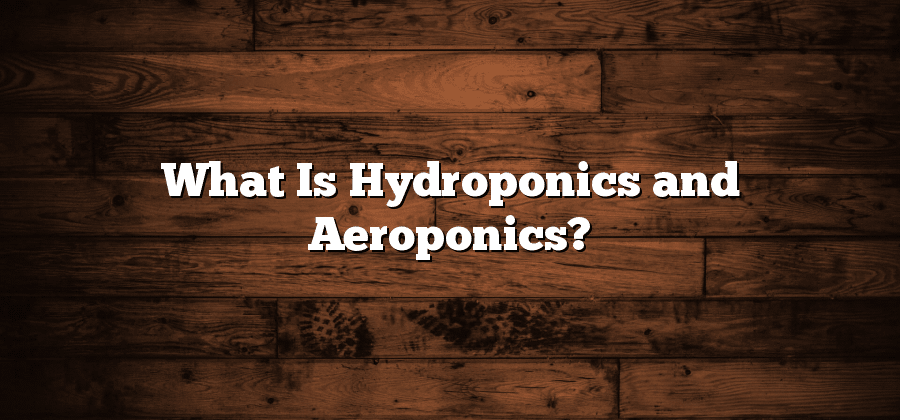The Revolutionary Techniques of Soilless Cultivation
Hydroponics and aeroponics are two revolutionary techniques of soilless cultivation that have been gaining popularity in the agricultural industry. Both methods offer unique advantages and are changing the way we grow plants.
In hydroponics, plants are cultivated in nutrient-rich water without the use of soil. Instead, they are supported by an inert medium like coconut coir, perlite, or rockwool. This method allows for precise control over the nutrient content, pH levels, and water availability, resulting in faster growth rates and higher yields. Additionally, hydroponics requires less water and space compared to traditional soil cultivation, making it an ideal choice for urban farming and areas with limited resources.
Understanding Hydroponics: The Basics Explained
Hydroponics is a modern method of growing plants without soil, using only water and nutrient solutions. This technique has gained popularity in recent years due to its numerous advantages and the potential to achieve higher crop yields. One of the key benefits of hydroponics is its ability to conserve water. Unlike traditional agriculture, hydroponics recirculates water, allowing for minimal wastage and reducing the overall water consumption. Additionally, since plants in a hydroponic system receive nutrients directly through water, they can absorb nutrients more efficiently, resulting in faster growth and healthier plants.
Exploring Aeroponics: An Innovative Growing Method
Aeroponics is an innovative growing method that is gaining popularity in the world of agriculture. Unlike traditional methods that rely on soil or water to deliver nutrients to plants, aeroponics relies on a nutrient-rich mist that is sprayed directly onto the plant roots. This mist contains all the essential nutrients required for plant growth and is delivered in a highly oxygenated environment.
The benefits of aeroponics are numerous. First and foremost, it allows for faster and more efficient plant growth. The direct delivery of nutrients to the roots ensures that plants receive the necessary nourishment without any wastage. Additionally, the highly oxygenated environment promotes faster root development and better nutrient absorption. This results in healthier, more productive plants with higher yields. Another advantage of aeroponics is its water-saving capabilities. As the plants receive nutrients through mist rather than through a soil-based system, water usage is significantly reduced. This makes aeroponics a sustainable and environmentally friendly growing method, particularly in regions with limited water resources.
The Advantages of Hydroponics and Aeroponics Systems
Hydroponics and aeroponics systems offer numerous advantages over traditional soil-based cultivation methods. One of the key benefits is the ability to significantly increase crop yields. By providing plants with precisely controlled nutrient solutions, these systems enable optimal growth conditions, resulting in larger and healthier crops. Moreover, because nutrient delivery is carefully regulated, plants can absorb nutrients more efficiently, leading to faster growth rates and shortened growth cycles. This means that farmers and growers can harvest multiple times in a year, maximizing their productivity and profitability.
Another advantage of hydroponics and aeroponics systems is their ability to conserve water. Unlike conventional farming, where a significant amount of water is lost through evaporation and runoff, these soilless cultivation methods recycle water. Using closed-loop systems, water can be continuously circulated and reused within the system. This not only reduces water waste but also addresses concerns about water scarcity, a pressing issue in many regions. Additionally, these systems allow for precise water management, ensuring that plants receive the right amount of moisture, further optimizing their growth potential.
In conclusion, hydroponics and aeroponics systems offer several advantages that make them an attractive alternative to traditional soil-based cultivation. From increased crop yields to efficient water usage, these innovative growing methods have the potential to revolutionize agriculture and address the challenges of feeding a growing population.
Essential Components for Successful Soilless Cultivation
Soilless cultivation, also known as hydroponics or aeroponics, is becoming increasingly popular among farmers and gardeners. This innovative growing method offers several advantages over traditional soil-based cultivation, including better control over nutrient levels, increased crop yields, and improved water efficiency. However, in order to successfully implement soilless cultivation, certain essential components must be in place.
First and foremost, a reliable water supply is crucial for soilless cultivation. Hydroponics and aeroponics systems require a constant flow of water in order to deliver nutrients to the plants. This water supply must be clean and free from contaminants that could harm the plants or disrupt the balance of nutrients. Additionally, the water supply must be easily accessible and properly regulated to ensure consistent delivery.






